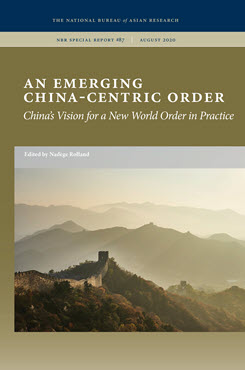NBR Special Report no. 87
An Emerging China-Centric Order: Introduction
This introduction to the NBR Special Report “An Emerging China-Centric Order: China’s Vision for a New World Order in Practice” is by Nadège Rolland, Principal Investigator for the project China’s Vision for a New Regional and Global Order.
Long before the Covid-19 outbreak hit China and spread to the rest of the world, Xi Jinping, standing on a podium at the Great Hall of the People in Beijing, heralded the dawn of a “new era” for the Chinese nation that “has stood up, grown rich and become strong, and…now embraces the brilliant prospects of rejuvenation.” This new era, Xi declared, will “see China moving closer to center stage and making greater contributions to mankind.”[1]
The extent to which the Covid-19 pandemic has affected global trends and national trajectories cannot yet be fully appreciated. Conjectures abound, with prophesies of a total upending of the world order at one end of the spectrum and forecasts of a steady acceleration of pre-pandemic trends at the other. As we publish this report, the aftereffects of the pandemic on the global economy, and on China’s economic growth in particular, are still unclear. How it will affect China’s geopolitical calculations and global ambitions is also difficult to tell. But the Chinese leadership has given indications of its determination to keep moving forward. Having proclaimed a new era of strength and power for China, it would be difficult for the secretary general of the Chinese Communist Party (CCP) to revert to a low-key posture. Foreign Minister Wang Yi observed, for example, in April 2020: “Human history is a story of mankind wrestling with various diseases and disasters, always emerging stronger and more resilient. Unequivocally, Covid-19 cannot arrest the Chinese people’s determined march toward national rejuvenation.”[2] In his assessment of the impact of the pandemic on China’s “centenary goals,” Yuan Peng, the president of China Institutes of Contemporary International Relations, contends that China’s “strategic deployment is unrolling methodically,” even though the uncertain and unstable international environment makes it more difficult for the country to seize opportunities.[3]
As China is stepping out more assertively and decisively than ever since the foundation of the People’s Republic of China, it has become crucial for the rest of the world to grasp as thoroughly as possible the vision China has for itself as a preponderant power on the global stage. The Chinese leadership not only is striving for great-power status but also has embarked on a journey to reshape, alter, and redefine elements of the existing international system to better fit its worldview and interests. It has therefore become imperative to better understand the kind of changes China would like to see occur, as well as the types of mechanisms, institutions, norms, and rules that Beijing would like to see arise as part of this new international system.
With this objective in mind, the National Bureau of Asian Research (NBR), with the generous support of the Carnegie Corporation of New York, launched the project “China’s Vision for a New Regional and Global Order” in early 2019. The project’s first report, published in January 2020, disentangles the strands of thought behind Chinese elite’s vision for a new world order and depicts its emerging features, based on a careful examination of Chinese-language sources. The study concludes that the Chinese elites seem to favor a limited form of Chinese supremacy, vaguely reminiscent of the ancient tributary system, loosely exercised over the “global South” rather than geographically surrounding China, and characteristically neither democratic nor liberal—a “partial, loose, and malleable hegemony.”[4] This characterization reflects ongoing internal deliberations, most of them elaborated in the abstract, and is not a description of Beijing’s concrete aspirations. At the same time, examining the current debates helps identify some prominent elements that may move from abstract conceptions and theory to practice.
Is this vision for a world order “with Chinese characteristics” starting to translate into reality? Are some of its main features already detectable in the way China manages its relationships and interactions with countries and international institutions, or in the norms Beijing is championing globally? To extract the predominant characteristics of China’s diplomatic practice, one would have to comprehensively examine, compare, and contrast China’s bilateral and multilateral interactions and efforts, all at once and across the board. Instead, we have chosen to consider a few case studies that seemed particularly relevant to illustrate whether and how Beijing is attempting to develop a “partial, loose, and malleable” form of hegemony. The essays collected in this report examine two countries (Cambodia and South Korea), two institutions (the UN Human Rights Council and the 17+1 platform), two norms (right to development and cyber sovereignty), and one functional domain (development assistance). Each essay investigates China’s objectives, describes its favored tools to achieve them, and assesses the effectiveness of its efforts with regard to these objectives.
Besides the seven essays presented in this report, NBR also convened a virtual private roundtable at which experts shared their insights on eight complementary case studies. These covered China’s interactions with Ethiopia (Maria Repnikova), Myanmar (Jason Tower), Serbia (David Shullman), Sri Lanka (Nilanthi Samaranayake), and the Forum on Africa-China Cooperation (Lina Benabdallah) and China’s approach to international law (Thomas Kellogg), industrial standards strategy (Jack Kamensky), and the global information ecosystem (Shanthi Kalathil). Finally, four senior advisers (Harry Harding, Roy Kamphausen, Jennifer Lind, and Andrew Nathan) assisted in directing and reviewing the research efforts throughout the process. The current phase of the project greatly benefited from their intellectual input and guidance, and I am indebted to them for the time they have generously invested and the positive energy they have instilled.
In the opening essay, Chris Horton examines Beijing’s high degree of influence over Hun Sen’s Cambodia in all possible domains. In the last five years, Cambodia has seen a rapid influx of Chinese investment in a variety of economic sectors. Within both the Association of Southeast Asian Nations (ASEAN) and the United Nations, Phnom Penh can be trusted to vote on China’s behalf. Security cooperation has increased, too, which may eventually give the People’s Liberation Army a local footprint from which to project power. Consolidated ties with China strengthen the increasingly authoritarian Hun Sen regime.
Adam Cathcart studies the dynamics between South Korea and China under Xi Jinping. While successive Korean leaders have tried to keep a middle ground between Beijing and Washington, they have also been attracted by the promises of Xi’s Belt and Road Initiative and its potential for a further enmeshment of North Korea into the broader region. China is nurturing ties with Seoul, using both soft influence and intimidation tactics, in an effort to pull South Korea closer into its orbit and weaken the country’s alliance with the United States.
Andréa Worden’s essay examines in detail China’s challenge to the current international human rights framework and to universal values within the UN Human Rights Council. Beijing has become increasingly aggressive in seeking the implementation of its right to development agenda and is making steady progress in gathering support for redefined rights that will allow governments to avoid accountability for human rights abuses. Worden meticulously depicts the long list of coercive methods China uses to obtain greater leverage and increase its discourse power within the institution.
Justyna Szczudlik examines the trajectory of the 17+1 (formerly the 16+1) mechanism, a purportedly multilateral platform created by China in early 2012 to promote cooperation with Central and Eastern European countries. Following Xi’s arrival to power and adoption of a more proactive foreign policy orientation, the format has evolved from a primarily economic focus into an instrument that serves Beijing’s overarching geopolitical objectives. Szczudlik’s essay describes how the platform has become China’s main tool to promote and project Chinese norms, values, and standards in Central and Eastern European countries and assesses its successes and failures.
Malin Oud analyzes how the concept of the right to development has been a centerpiece of official Chinese human rights policy for the last three decades and eroded universal human rights standards. She highlights how Beijing’s position has shifted from being primarily defensive to undertaking proactive efforts to reshape international human rights norms to better accommodate Chinese interests. The narrative surrounding the concept has also evolved—from characterizing the right to development as different from the Western liberal democratic model to asserting that this concept is superior to it, and from being domestically oriented to universally applicable. China has thereby frontally challenged established international standards and the principles of universality, indivisibility, and rule of law.
Adam Segal considers China’s increased proactiveness in shaping the global governance of cyberspace around its preferred concept of cyber sovereignty. Beijing’s vision originates from a domestic desire for more tightly controlled information flows and content, enhanced cybersecurity, and increased technological independence and has stark implications for a global internet that will become less open and free. China’s recent outreach is not the only reason for a growing international embrace of the concept of cyber sovereignty, however. Based on their own assessments of threats, more governments seem to be willing to accept a higher degree of regulation of the internet, which coincides with Beijing’s interests.
Finally, Alisée Pornet describes how China has become a structural actor of change in development finance practices and norms. It has done so by incrementally moving the lines in the existing system rather than attempting to create everything anew or to entirely reshape the global aid architecture. Over the last decade, China has been more proactive in defining the parameters of its international development programs and creating multilateral financial institutions, which culminated with the launch of the Belt and Road Initiative. Its overseas development policies exhibit distinctive characteristics and differ from the existing model of international aid, and their influence has expanded along with China’s international footprint.
The seven experts who authored the essays in this report have taken on an extremely thorny assignment. They were asked to identify and uncover the most significant elements of a system—or rather, of a “vision”—that has not yet emerged and whose characteristics are yet to be clearly defined. Their findings help identify the main features of Beijing’s preferred arrangements as Chinese influence expands worldwide and across domains.
Nadège Rolland
Senior Fellow for Political and Security Affairs
The National Bureau of Asian Research
Endnotes
[1] “Socialism with Chinese Characteristics Enters New Era: Xi,” Xinhua, October 18, 2017.
[2]Wang Yi, “Following Xi Jinping Thought on Diplomacy to Build a Community with a Shared Future for Mankind through International Cooperation Against COVID-19,” Ministry of Foreign Affairs of the People’s Republic of China (PRC), April 19, 2020.
[3] Yuan Peng, “Xinguan yiqing yu bainian bianju” [New Coronavirus Pandemic and Once-in-a-Century Changes], Xiandai guoji guanxi, no. 5 (2020), http://www.cssn.cn/gjgxx/gj_qqwt/202006/t20200617_5144113.html. The two centenary goals (liangge yibainian) refer to objectives set by the leadership for the one hundredth anniversary of the founding of the CCP in 2021 and the centenary of the founding of the PRC in 2049.
[4] Nadège Rolland, “China’s Vision for a New World Order,” National Bureau of Asian Research, NBR Special Report, no. 83, January 2020.



